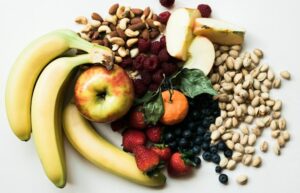BLOOD PRESSURE: IS THERE MORE TO IT THAN SALT?

Achieving and maintaining optimal blood glucose, cholesterol and blood pressure levels will reduce your risk of developing cardiovascular diseases (CVD) like heart disease and stroke which are two of the biggest killers, globally.
While there is good evidence that blood pressure is affected by the type and amount of carbohydrate consumed (i.e. glycemic index and load), the overall body of scientific evidence indicates that essential minerals have more powerful effects on this important CVD risk factor.
The 3 most important essential minerals with respect to blood pressure are sodium, potassium and calcium.
Sodium (salt)
With all the negative headlines in the media about sodium or salt in our foods, it’s easy to forget that it is an essential nutrient that has a number of important functions within our bodies including maintaining fluid balance within our cells and organs, it also helps to regulate acidity, and is an essential component of nerve impulse transmission.
Dietary guidelines around the world recommend that people eat less, or limit, added salt and salty foods. The salt they are mainly talking about is sodium chloride, which is the most common salt added to foods, and has been consumed as a condiment by humans for many thousands of years. As well as enhancing flavour, salt has other important roles in food including acting as a preservative and affecting a foods texture. Salt is approximately 40% sodium and 60% chloride.
The World Health Organisation (WHO) currently recommends that adults consume less than 2 grams (2,000 mg) of sodium, which is equivalent to less than 5.1 grams of added salt, each day. Population surveys from around the world indicate that most people eat more salt than is required for good health. The most recent Australian Health Survey, for example, indicates that the average Australian adult consumes over 2.4 g (2,430 mg) of sodium each day, equivalent to over 6.2 grams of salt. Importantly, men consume on average 2,779 mg and women consume 2,090 mg.
While advice to reduce the amount of sodium in the diet makes good sense for most people, it is important to remember that we do not need to completely avoid all sodium. Like most nutrients, too little sodium may not be good for our health either. Indeed, a recent large study of adults living in 17 countries found that both lower (less than 3 g) and higher (more than 6 g) sodium intakes were associated with an increased risk of major cardiovascular events like heart attack and stroke, and that intakes in the middle were associated with the least risk. There is also some evidence in people with diabetes that very low salt intakes may increase the risk of cardiovascular disease. We probably shouldn’t be surprised, this phenomena – characterised by a U or J–shaped curve – is quite common in human nutrition: too little of a particular nutrient really can be just as detrimental to health as too much.
Simple ways of reducing your salt intake include:
- When shopping, look for products that are ‘salt reduced’ or have ‘no-added salt’.
- Reduce or omit salt in cooking.
- Avoid sea salt, rock salt, garlic salt, chicken salt, etc… as they are not suitable substitutes for salt.
- Instead of using salt to flavour foods try using spices such as pepper, garlic, chilli, mustard, curry, paprika and cardamom.
- Add herbs like parsley, basil, oregano, chives, rosemary, coriander, mint, sage, thyme, tarragon and marjoram.
- For extra flavour add lemon juice, onions, ginger, shallots, vinegar, wine or salt reduced stock.
- Avoid putting salt on the table.
Potassium
Most of us know that potassium is “good for us” and that bananas are a good source of it. Potassium is of course an essential nutrient, just like sodium, and has a number of important functions within our bodies including maintaining fluid balance within our cells and organs, it also helps to regulate acidity, and is part of the hydrochloric acid found in our stomachs, that is necessary for proper digestion of foods.
One of the reasons why dietary guidelines around the world advise us to eat more vegetables and fruits is because they are all good sources of potassium (not just bananas). Best sources of potassium include:
- leafy green vegetables, such as bok choy, silverbeet, spinach, etc…
- vine fruit such as tomatoes, cucumbers, zucchini, eggplant and pumpkin, and
- root vegetables (potatoes, sweet potatoes, carrots, etc…
Moderately good sources include:
- beans (e.g., baked beans, kidney beans, etc…) and peas
- dried fruits
- fresh fruits such as apples, oranges and bananas.
It’s worth knowing that milks, yoghurts and unprocessed meats also contain potassium, although not as much as vegetables and fruits.
While consuming too much sodium will raise some people’s blood pressure, relatively higher intakes of potassium are associated with lower blood pressure, and lower risk of cardiovascular disease. What this really means is that the balance, or ratio, of sodium to potassium is what really counts when it comes to blood pressure and cardiovascular disease risk. Indeed, the WHO recommends adults consume at least 3,510 mg of potassium per day, and that the sodium : potassium ratio be no more than 1 : 1, or in other words, you should aim to consume more potassium than sodium.
The most recent Australian Health Survey indicates that the average Australian man consumes 3,212 mg and woman 2,620 mg – both less than recommended by the WHO.
Calcium
It may not come as a surprise to learn that calcium is the most abundant mineral in our bodies, as it is one of the essential components in our bones and teeth. In addition to this essential role, calcium is also involved in the contraction of our muscles (including our heart), in nerve impulse transmission, blood clotting, and immune function. While not so well known, calcium also has an effect on blood pressure as both sodium and calcium excretion is linked in our kidneys. The more calcium you consume, the more sodium you excrete in your urine, and vice versa. This is likely one reason why consumption of dairy foods is linked to decreased risk of CVD.
Dietary guidelines around the world advise us to consume milk, yoghurt, cheese and/or their alternatives. While calcium is found predominantly in mammalian milk, dairy foods, fortified soy beverages and alternatives, moderate amounts can also be obtained from bony fish (e.g., salmon, sardines, etc…), legumes (beans, lentils, chickpeas) and certain nuts (e.g., almonds, walnuts, etc…). Eating 2-3 serves of reduced or low-fat dairy, or fortified alternatives, is currently recommended.
As far as absolute intakes of calcium are concerned, younger men and women should aim to consume 1,000 mg each day, and older men and women (>70 years) to consume 1,300 mg each day to reduce the risk of developing osteoporosis and to maintain good general health.
The most recent Australian Health Survey indicates that the average Australian man consumes 866 mg and woman 745 mg – both considerably less than recommended.
Conclusion
There’s more to achieving and maintaining optimal blood pressure than simply eating less salt. Consuming more foods and beverages high in potassium and calcium is also very important. In other words, don’t just reduce salt, also eat more fruits and vegetables, milk and yoghurt or quality alternatives.
Read more:
- ElSayed and colleagues. 10. Cardiovascular Disease and Risk Management: Standards of Care in Diabetes-2023. Diabetes Care. 2023
- World Health Organisation. Guideline: Sodium intake for adults and children. WHO, 2013.
- World Health Organisation. Guideline: Potassium intake for adults and children. WHO, 2012.
- Barclay. Reversing Diabetes. Murdoch Books. 2016








